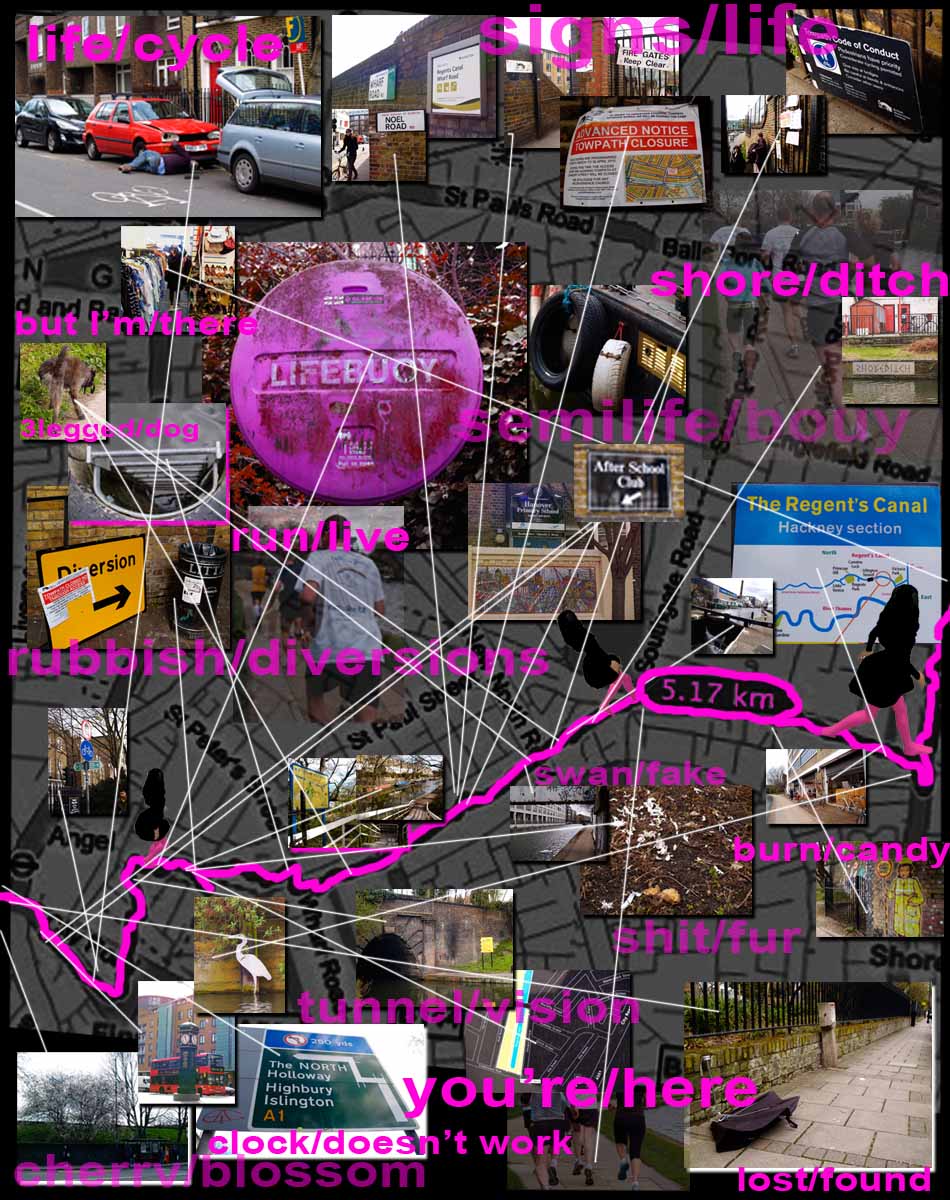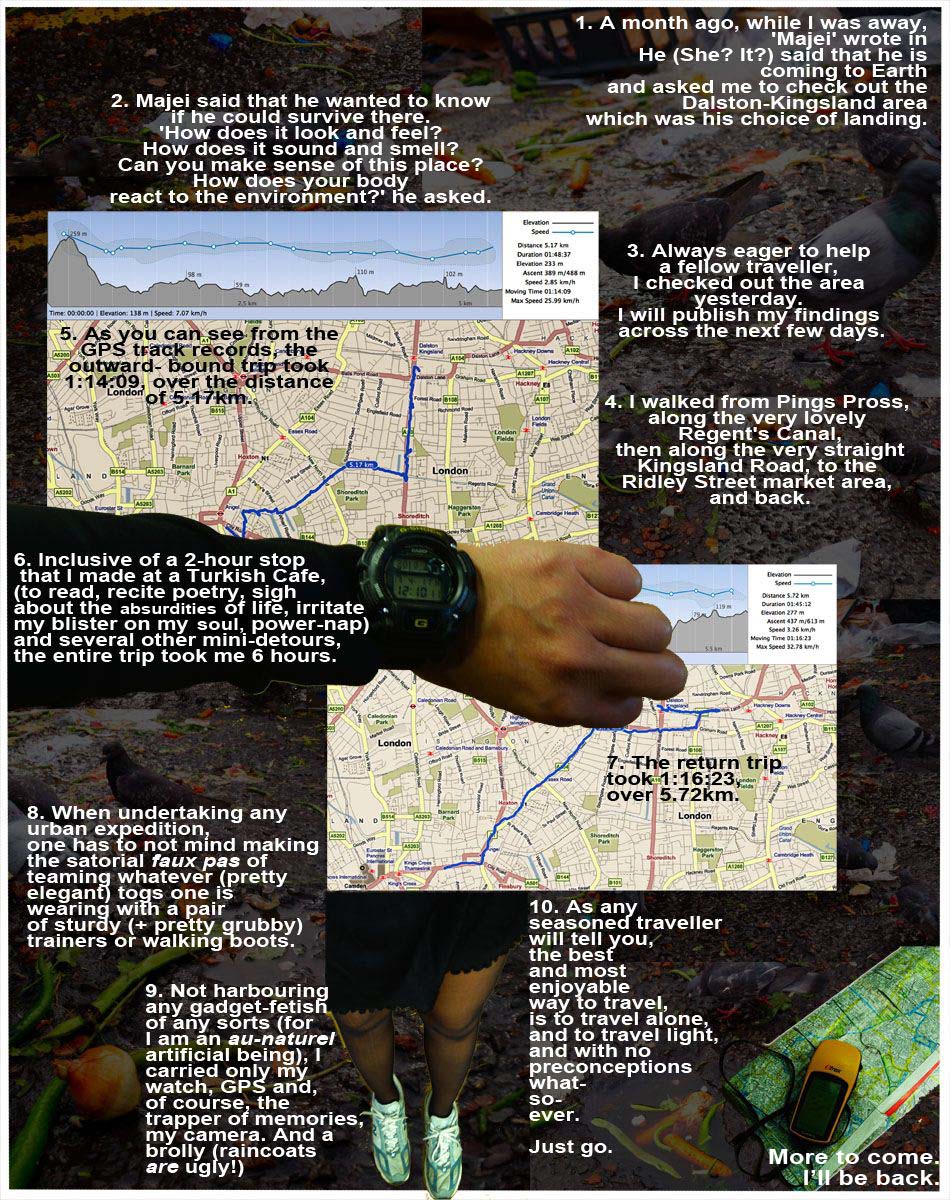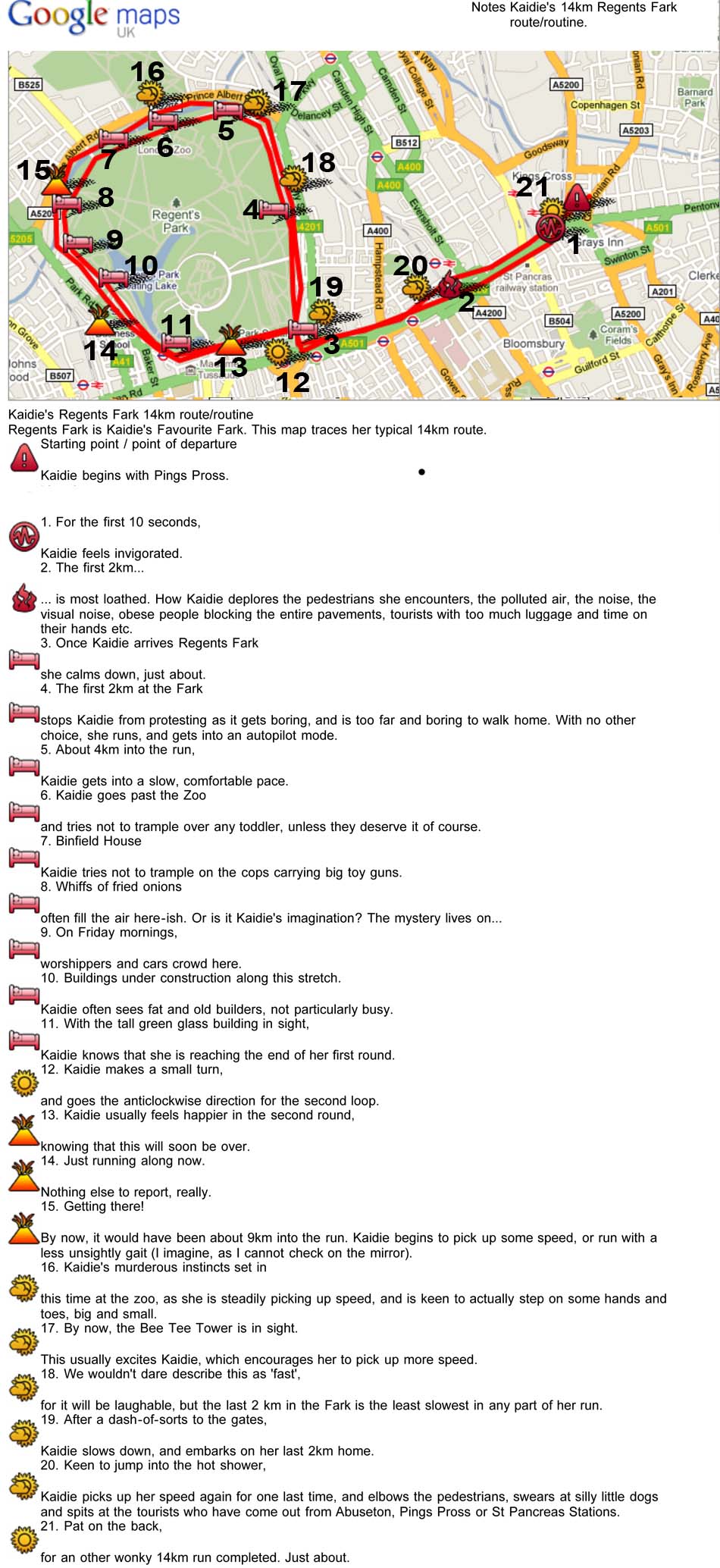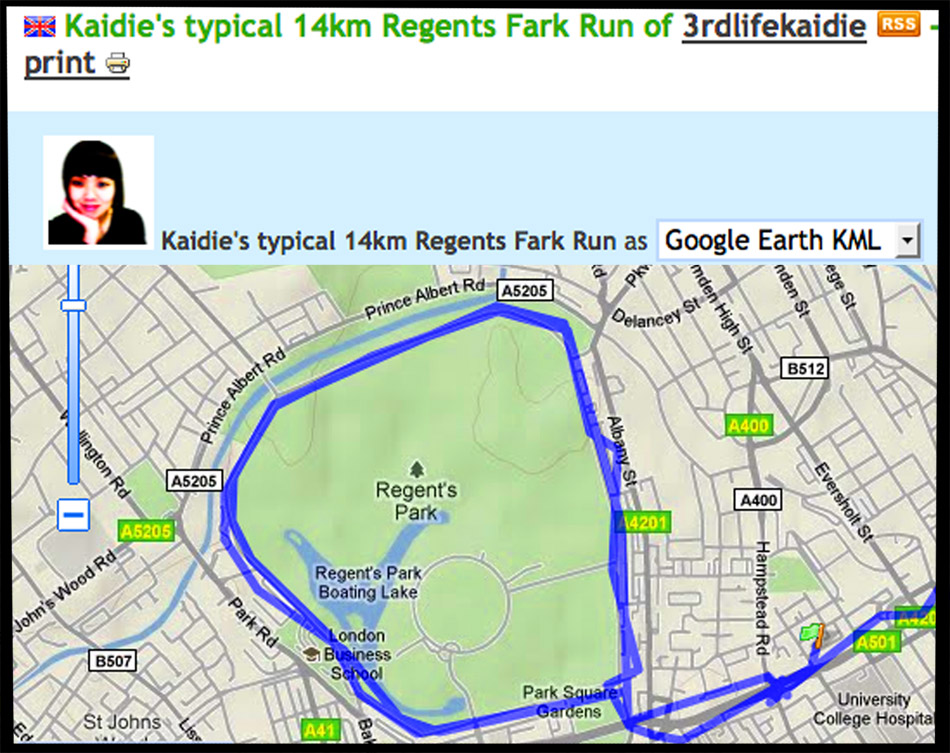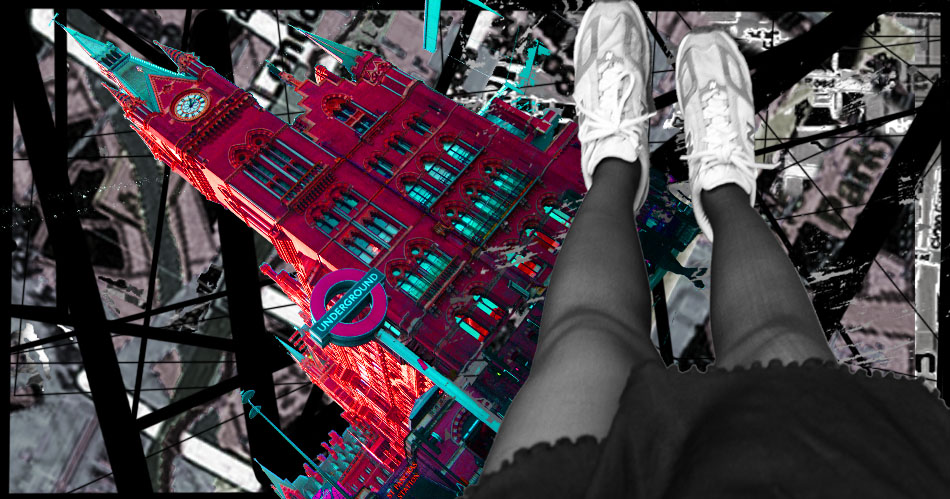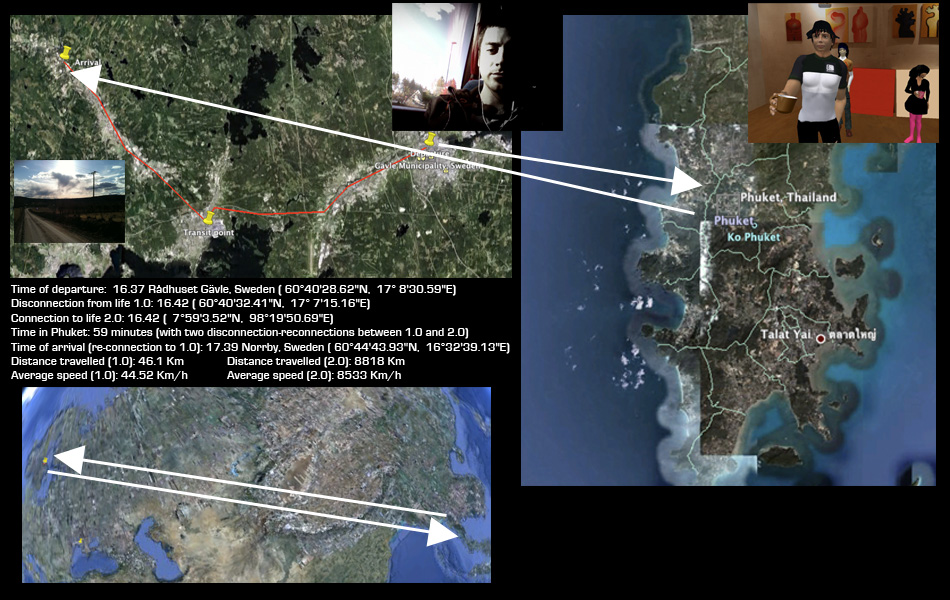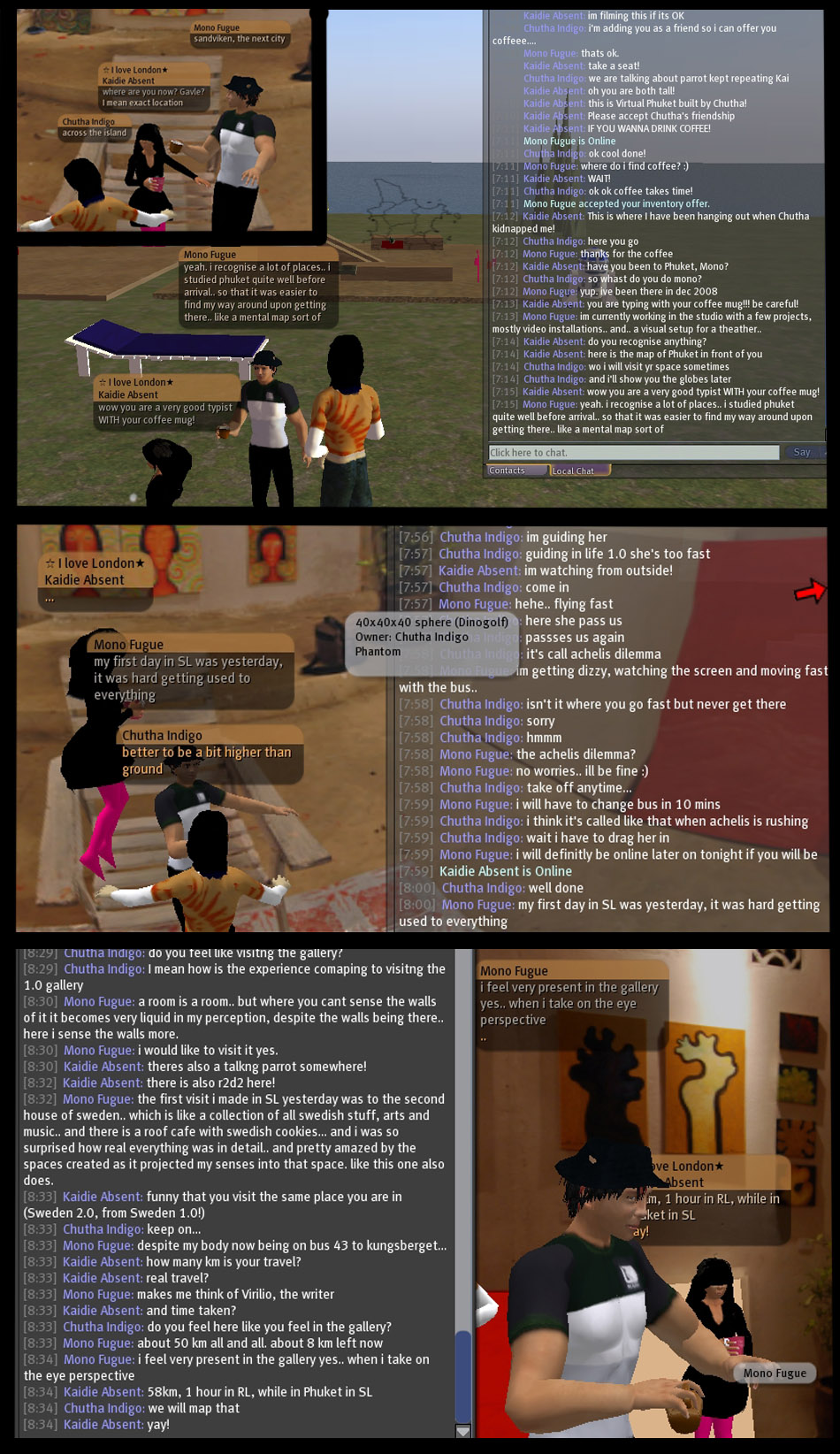DOCUMENTATION OF 3.0, 2.0, 1.0! READY, GET SET, GO! RUN FOR (Y)OUR LIVES! 22 March 2010 performance.
8 minute lecture-performance by Kailives, standing in for Kaidie, on the eve of Kaidie’s 100th day birthday and her continued dis-location. Kailives discusses the philosophy of Life 3.0, and the gap between theory (of Life 3.0) and (Kaidie’s) practice (of her semblance of life). Unbeknownst to Kailives, however, towards the end of the performance, Kaidie makes a brief appearance – right behind Kailives back, on screen!
The performance was filmed by the wonderful performance artist/filmmaker Jayne Parker. Off The Shelf, a 1-night word-image event, was curated by Sharon Morris and Jon Thomson, at the Slade School of Fine Art, University College London, UK, 22 March 2010, Monday. Kaidie’s segment came on at around 2130hrs.
**There was a gap in documentation towards the end of the performance due to tape change**
** There will be an upcoming gig at the end of June in the city of Nondon! For updates, watch this space! For gigs that Kaidie has performed so far, watch that space! **
KAIDIE’S SLIGHT DETOUR/DIVERSION/REALITY CHECK: ON HERZOG’S ENIGMA OF KASPER HAUSER (Catch on BBC iplayer now!)

Werner Herzog at the San Francisco International Film Festival, 1999. Frame grab from final chapter of Chlorine Addiction by Kai Syng Tan (2000)
If it wasn’t for this (this tedious 1000-day hell of an ‘epic’ endeavour, of Kaidie’s quixotic running across dimensions in search of the so-called ‘Meaning of Life 3.0’), we could possibly have conducted our research on Werner Herzog, as we had contemplated at some moments of our previous lives. How nice now, in this life, to revisit his The Enigma of Kasper Hauser (1974).
The classic Herzogian leitmotifs are there: beasts (fainting chicken, kneeling camel), outcasts/freaks (myth of tiny king with tiny kingdom, each king tinier than before; Kasper Hauser himself); freak shows (including the film we are watching); dreamscapes (ditto, and Kasper’s flickering Super-8 Sahara dreams); hero/anti-hero (Kasper/Bruno S.); character/actor, acting/not acting (Kasper/Bruno S.); ‘realism’ vs self-mythologisation (including Herzog’s own); the clash of cultures/civilisations (Kasper scrutinised again and again as an Other; “Mother, I have been so cut off from the world”, says Kasper, holding her baby); an assault on ourselves (the Other or the ‘idiot-savant’/savage being more enlightened and more civilised than us); power play and cruelty (boys at chicken and Kasper); moments of tenderness (Kasper playing with black crow, recalling the iconic image of Klaus Kinski playing with monkey in the final scene of Fitzcarraldo); man vs nature (“Let the apples sleep, they are tired.”); man and art (“The music feels strong in my heart. All of a sudden I feel old. Why can’t I play the piano like I breathe?”); godlessness and the absence of redemption (the subtitle, Every Man for Himself, and God Against All of Them, says it all.)
Controversial and problematic as his work and methodologies were/are, Herzog always haunts and provokes, in a manner that is austere, Brechtian and unsentimental as it is acutely Romantic.
In a previous life, I saw the filmmaker speak at the San Francisco International Film Festival. (I had rushed back to the cinema from my tour around San Francisco of Hitchcock’s film locations of Vertigo – the very same tour that Chris Marker took, I am told, to film the passage that pays homage to Vertigo/Madaleine’s ghost, in his Sans Soleil). As usual, Herzog spoke contemplatively, measuredly, in flawless English with his unmistakably charming accent (but he offered an obligatory ‘apology’ for his ‘bad English’ at the beginning of his speech), punctuated with calculated pauses (Is that Herzog narrating the final dream sequence in Kasper?)
Herzog reminds us of many things, and reminds Kaidie the need to keep running and not lose her vision, flickering and faint as they may be at times. (She is short-sighted after all. Time to clean her mouldy glasses.)
A ROUGH GUIDE TO REGENT’S FARK: KAIDIE’S MOOMOODYMOODMOOD MAP OF HER TYPICAL RUN AT HER FAVOURITE FARK.
You can take a look at the same route tracked sehr scientifically using GPS on my page in GPSies – albeit ending up at my local Pesco’s to buy 35 tubs of some of my favourite jellied eel. Starting from last week, however, Kaidie has upped her training to 1 more loop, in preparation for her first ever Life 1.0 marathon in September, making it a total of about 18km under 2 hours each time. More updates about the race soon! Watch this space. Don’t you dare blink.
IT’S DAY 152, AND KAIDIE CERTAINLY HAS MUCH CATCHING UP TO DO. In the midst of trying to make sense of Nondon now/here.
Hello world. Again. I’ve run back to run my own lives. For now.
For the benefit of those of you who have just joined me on my quest, here’s a summary of the events in March and April: On 2 March, while running along Fuston Road, I fell head-over-heals. I dislocated a part of my body. Thereafter, I could not be located. I had been kidnapped by The Good Pirate into the world-within-world-within-world of Phuket 2.0 in Second Life. In my absence, a reader, Kailives, hacked into my account and ran my lives on my behalf, by maintaining this blog, my Facebook Twitter and Youtube pages, as well as standing in for a few of my gigs. I did make brief appearances in some of these events, and that was how my whereabouts was uncovered. Finally, on my 5th-month birthday, I decided to break free from my kidnapper, and left the metaverse.For better or for worse, but for a restless runner, it is certainly not for good.
Kailives did try her best to do my job in my absence. However, in this collaborative quest of the meaning of Life 3.0 of Kaidie’s, there were several issues that her co-runners raised that made Kaidie slightly dumbfounded. Some of them are reproduced in the above image. In the coming weeks and months, I will have to try to think about them and respond to them. So, my dear readers and fellow-runners, thank you very much indeed for all your advice and support so far. Please do be patient and give me some time to carefully look at your advice. Kailives has left, but if need be, I may get her back, if I need her voice.
At this point, however, I can respond loud and clear, in absolutely no uncertain terms, that I will have to say no to the suggestion that Kaidie should make a baby in her quest for the meaning of Life 3.0. Kaidie’s response is NO, no, no thank you, never. No. Kaidie will make no baby. Especially not now, given the way things seem to be heading in Nondon.
TRAVELLING IN THE WORLD-WITHIN-WORLD-WITHIN-WORLD OF THE METAVERSE
 The following is an other one of several imaginary discussions between ‘Pro-First-Lifers’ (realists who value meatspace more than our virtual) and ‘Pro-Second-Lifers’ (Cyber-enthusiasts and those who celebrate the power of imagination), in a fictitious online academic forum. Entitled (How) Does Physics Function In Cyberspace? Metaphysical Enquiries For The 21st Century: An Online Peer-To-Peer Peer-Reviewed Forum, subscribers include very serious philosophers, psychologists, media theorists, writers, cyber-geographers, cyber-artists, cyber-anthropologists and cyber-anybody-else. And very, very serious PhD students. However, it is sometimes unclear which side they speak for. It is also suspected that some of the subscribers may have more than one account and speak from different sides. Like the real world, the online world is not black and white …
The following is an other one of several imaginary discussions between ‘Pro-First-Lifers’ (realists who value meatspace more than our virtual) and ‘Pro-Second-Lifers’ (Cyber-enthusiasts and those who celebrate the power of imagination), in a fictitious online academic forum. Entitled (How) Does Physics Function In Cyberspace? Metaphysical Enquiries For The 21st Century: An Online Peer-To-Peer Peer-Reviewed Forum, subscribers include very serious philosophers, psychologists, media theorists, writers, cyber-geographers, cyber-artists, cyber-anthropologists and cyber-anybody-else. And very, very serious PhD students. However, it is sometimes unclear which side they speak for. It is also suspected that some of the subscribers may have more than one account and speak from different sides. Like the real world, the online world is not black and white …
Since March 2, Kaidie has been running about in Second Life as Kaidie Absent, having been kidnapped by The Good Pirate, a.k.a. Chutha Achavasmit, away from Life 1.0. The images we see here are screen grabs from Kaidie’s Cyberspace Odyssey in the past 2 months.
Perhaps it is about time Kaidie runs out of the Metaverse, and come ‘back’ to run her Life 1.0, Life 2.0 and Life 3.0 by herself.
…
Bruce Damer: The surface area of virtual worlds (if an avatar’s height is taken as a unit of measure) will probably exceed the surface area of the Earth within a couple of years.[1]
Pro-Second-Lifer C: Thanks to the Internet, my world has expanded vastly. Cyberspace is a not only a great place to visit – within there, there are so many more worlds that I can inhabit. The attraction of the virtual worlds of MUDs and MMOGs is how nearly anything is possible, including things I cannot do in Life 1.0, and things that once only belonged to the realms of my imagination in Life 2.0. Thus is their attraction, as their popularity attest. China alone recorded 55.5 million online gamers by 2008, with the total market value for virtual transactions at RMB 10-13 billion[2]. What Damer said in late 1997 with respect to Alpha World is not far fetched (although hitherto unverified, to be sure). According to Edward Castronova, tens of thousands of people are logged on into virtual worlds at a time, 24 hours a day, all year round. And, for many, ‘life in the virtual reality spaces seemed preferable to life on Earth.’[3]
Wagner James Au: On an innovation scale, Second Life suggested the potential for MMOs to also be a development platform for commercial, educational, and research projects. […] In South Korea, an estimated one in twelve members of the entire population have played an MMO called Lineage; in China, a whole cottage industry is devoted to “gold harvesting”, the acquisition of gold coins and other fictional money in MMOs. […] As broadband and high end PCs saturate the international market, it’s time to consider MMOs as the likeliest candidate for the Internet’s next generation, supplanting the two dimensional, semi–interactive portal of the Web for an immersive, three–dimensional, fully interactive Metaverse of data. [4]
Pro-First-Lifer C: I am baffled about these statistics of the happenings in Life 2.0, since I can hardly feel a thing in Life 1.0! What is shocking is how pervasive, in all aspects of Life 1.0, this impact has been! What is even more disastrous to contemplate, is Au’s mad prediction is that this mad fictive world within the already-mad Internet world will become the norm of the Internet! What on earth are the conditions that are behind this exodus, where you, and all the millions of gamers ‘leave the real world behind’[5]?
Edward Castronova: [… ]the industries that produce shared virtual reality environments [are developing] rapidly. Advances in connectivity (bandwidth) and interfaces (haptic devices, heads-up displays) have been driven by technology. The amount of available content (narratives, folklores, backstories) has expanded; the video game industry has begun to surpass the motion picture industry in gross revenues. As the phenomenon continues to grow, the aggregate amount of time devoted to shared virtual reality spaces seems likely to rise from today’s tens of thousands of person-years into the hundreds of thousands or perhaps millions.[6]
Pro-Second-Lifer C: There are no lack of examples of large corporations expanding into Cyberspace and building virtual worlds, such as Sony and Microsoft, and Electronic Arts, which support Sims. [7]
Edward Castronova: The Earth is very nice, but there are experiences we can imagine in our minds that we cannot have here. [8]
Pro-Second-Lifer C: Preferring the term ‘synthetic world’, Castronova defines one as ‘persistent online 3D spaces that replicate many of the features of the real world’. Similar to a video game character, the user negotiates synthetic worlds using a virtual body, known as an avatar. That thousands of people can be in the world at the same time make the environments ‘much like a real place, socially speaking’. The worlds, according to Castronova, ‘have a sort of fantastical yet logical reality to them, such that people can fly, but only if they have wings or a flying spell or happen to be birds to begin with.’[9]
William Gibson: A square of cyberspace directly in front of him flipped sickeningly and he found himself in a pale blue graphic that seemed to represent a very spacious apartment, low shapes of furniture sketched in hair-fine lines of blue neon. A woman stood in front of him, a sort of glowing cartoon squiggle of a woman, the face a brown smudge. “I’m Slide,” the figure said, hands on its hips…[10]
Pro-First-Lifer C: Do you not see the problem? These are much like, as Castronova says, but are definitely not real places. You are looking through what Tim Guest labels an electronic looking glass[11], and everything is distorted! You are going the dark streets, the downward spirals, where you would not have dare even thought of venturing in RL.
Pro-Second-Lifer C: What might the problem be? Take pornography – being highly stylised with its own sets of conventions, no one takes them to be ‘the real thing’, but simulations and performances. No pun intended, but pornography slips in and out of ‘reality’ as we know in Life 1.0, to the extent that it does not even matter if they are real or not. This would be the fictive world that philosopher Daniel Dennett says we do not question in this way, because it is not set out to be approached as such.[12] Reality is not the question. Whether something is real or not, or, for that matter, if it is distortion or not, is not the point. This is no different from your illicit agreement with the rules of cinema, when you enter a movie theatre. While you are in there, within the magic circle, you suspend your disbelief, and for the next 90 minutes watch a similar-looking, albeit also significantly different, world unfold in front of you. And it’s even better in a virtual world, since you can participate in it, and direct it!
Sherry Turkle: MUD players are MUD authors, the creators as well as consumers of media content. In this, participating in a MUD has much in common with scriptwriting, performance art, street theater, improvisational theater, or even commedia dell’arte[13].
Wagner James Au: Unlike most MMOs, Second Life encourages its subscribers (the preferred terms is ‘Residents’) to literally build the world with the construction and programming tools provided for them.[14]
Edward Castronova: A not insignificant fraction of the players of these games reported that they felt themselves to be not game players, but citizens of a new world.[15]
Pro-Second-Lifer C: From a wild, untamed piece of virtual land, entire mansions, towns and cities and be architected, hence increasing my sense of ownership and belonging in these worlds. Like Hiro, I can imprint my virtual addresses on my namecard. With a place to call home, and one I have built (or paid Linden dollars for someone else to build) at that, who wouldn’t want to keep going back back?
Pro-Second-Lifer D: Following Pro-Second-Lifer C’s previous line of thought, Cyberporn is even more attractive than porn, being a simulation-within-simulation, a double-simulation. Similarly, a virtual world, being a world within the world of cyberspace, is a double attraction. Virtual worlds are even better than pornography, since I am not only watching it, but participating in it! Well, very nearly. (Sex within virtual worlds is a topic that warrants long discussions – let us do that in a separate thread.) Hard-core Second-Lifers, such as the Second Life resident journalist Au, even go to the extent of describing cyber-activities outside of virtual worlds, such as emailing and blogging, as belonging to ‘real life’![16]
Wagner James Au: […] the experience of one’s alter ego being in an immersive space is experientially different from any other kind of Net–mediated interface that has come before it. Different, and in several key ways, better, than the limited, distanced, largely asynchronous interactivity of the Web as it exists now. An MMO quite literally offers a direct pathway into data, and global collaboration with an international community through avatars that afford each individual a high degree of anonymity, and paradoxically, an equally high degree of self–representation. With so much potential, and the technical/commercial infrastructure in place to make it feasible, it’s difficult to imagine online worlds not becoming the next real leap in the Internet’s evolution. [17]
Pro-Second-Lifer-D: Au is referring to immersion, that which distinguishes being embedded in a virtual world from other kinds of net-mediated interfaces. There are 2 types of immersions that Computer Mediated Communications (CMC) researchers have identified: ‘perceptual immersion’ and ‘psychological immersion’ (the latter drawing us back to the how we derive pleasure from pornography, the art of simulated pleasure – it is all in the mind). Hard at work as well here is the concept of flow.
Richard Bartle: Virtual world designers view psychological immersion as paramount, considering perceptual immersion to be merely one of many possible means to achieve that end. Immersion is also connected with the psychological concept of flow. […] Flow is an exhilarating sense of control and mastery that can arise from pursuing a focused, goal-driven activity; it’s a deep involvement that transcends distractions and sense of time, leading to an ecstatic state of peak productivity.[18]
Pro-First-Lifer-D: Call a rose by any name – flow and immersion are just fancy ways of saying the old, familiar dirty word: addiction.
Sherry Turkle: Stewart is logged on to one MUD or another for at least 40 hours a week. It seems misleading to call what he does there playing. He spends his time constructing a life that is more expansive than the one he lives in physical reality.[19]
Pro-Second-Lifer C: I do not mean to sound pedantic, but addiction has a physical component alongside the psychological one. The concept of flow, theorised by Mihaly Csikszentmihalyi is a positive and creative one, which refers to the ‘optimal state of experience for the individual is one in which intentions are not in conflict with each other’. [20] This is the state of heightened energy and focus where one could lose track of time. This altered state of consciousness is the same state experienced by a runner on a runner’s high, a person taking drugs or an artist at the peak of creativity.[21] And, if you wish to talk about an old, familiar dirty word, the word, my friend, is not ‘addiction’ but ‘TV’. Dr. Turkle certainly does not think of being in-world as automatically a bad thing.
Sherry Turkle: If the computer is replacing time with peers and parents, that’s not good. But if the computer is replacing television, then that may well be an upgrade.[22]
Pro-First-Lifer D: But Dr Turkle, you do not realise that the computer is the new TV! In 1895, the audience ran away at the sight of the approaching train in the Lumiere Brothers’ projection. And although the premise of Orson Welles’s radio prank was obviously improbable (invasion of aliens – or, for that matter, pancakes), listeners were sent into a panic. TV entered our living rooms and became our windows to the world; now the entire earth is brought to you on your laptop. We were enchanted then by the capability of these shrewd mimetic machines; today, we are still at the stage of enchantment by the Internet and its dark streets. Even better than photography and cinema, we are now able to not only mimic reality, but be more real than real. We need to unpack this simulacra, and like Barthes, track down, in the ‘decorative display of what-goes-without-saying’, the ‘ideological abuse’ hidden there[23] Break the fourth wall, step out of the magic circle and wake up from the evil dream!
Pro-Second-Lifer D: It is clear that not being of this (virtual) world, you cannot understand what we have said about the rules of the game, the ‘laws of nature’ in-world, if you like. Or, you are one of the spoilsports, what we term ‘griefers’ in-world.
Wagner James Au: Griefing is at heart an attempt to violate the implicit social contract needed to sufficiently maintain the consensus reality necessary for an online world to function. By looking for flaws in that implicit agreement, griefers often force the company and the community to examine basic assumptions in its structure — something potentially valuable in itself. […] [But, more] fundamentally, their behavior breaks the world itself, in a way that’s inexplicable from within the context of a world. Again, a shattering of the consensual reality not intended by the owners or the inhabitants, often through external, artificial means. [24]
Pro-First-Lifer D: ‘Consensual reality’? Mr Au, you have been in-world for so long that you are unable to spell properly. ‘Consensual unreality’, more like! How deluded are you! Are you all cultists, dimwits in denial, or simply mad? Or are you all failures of the real world, and hence escape and create alternative realities? Are you all blind wo/men with the elephant, and in Plato’s cave, or rather, Dungeon, as it were?! Nearly half of your lot – 43% – actually believe that what you do in-world is as important as RL, according to a new study. Unbelievable![25]
Pro-Second-Lifer D: What you said about artifice is extremely rich coming from your world as well – so many of your so-called rules are artificial constructs as well. Pick any – gender, sexuality, race, the list goes on. Surely we do not have to go into all that discussion again, for we have moved on. That is why we are here, in-world. And contrary to what you say, we are very much ‘awake’ and sober here, as everyone comes in knowing well that this is an artificial, constructed world, the ultimate Brechtian truth. I also argue that this is a more deliberate life, one that you enter willingly, than the one you are simply thrown into. Hence it is a life of a higher quality than Life 1.0, because you have come in of your own will, and you construct yourself as you like, and live as you wish.
Pro-Second-Lifer C: Pro-First-Lifer D, once again, recall what we said earlier about how much the real world is realising the importance of our Second Lives, by joining in. Au rightly points out the importance of positioning online worlds as a part of the real, echoing Dr Turkle’s reminder for us to take them as more than just games, but to pay attention to what they reveal about us[26]. The director of the USC Annenberg School Centre for the Digital Future, Jeffrey I. Cole, also remind us to pay attention to the Internet as a powerful medium.
Wagner James Au:[ …] [I]t’s time to approach these worlds with the seriousness they deserve — to treat online worlds as an essential, inseparable part of our contemporary experience.[27]
Sherry Turkle: Some are tempted to think of life in cyberspace as insignificant, as escape or meaningless diversion. It is not. Our experiences there are serious play. [28]
Jeffrey I Cole: More than a decade after the portals of the worldwide web opened to the public, we are now witnessing the true emergence of the internet as the powerful personal and social phenomenon we knew it would become The internet has been a source of entertainment, information, and communication since the web became available to the American public in 1994. However, we are now beginning to measure real growth and discover new directions for the Internet as a comprehensive tool that Americans are using to touch the world. [29]
Pro-Second-Lifer D: I shiver at bit at Cole’s last statement though – is he implying an American online invasion?!
Pro-Second-Lifer C: Let’s just ignore his bragging. Pro-First-Lifer D, I have yet more examples of interesting First Life presence in Second Life, which reminds us of the point raised by Dr Dodge about how ideology comes into play in cybergeography. In 2007, news website Islam Online created a virtual Mecca in SL, and in the first Hajj, 7,000 people ‘made the journey without even moving’. Not only does this help to provide some relief to the some annual congestion of two million pilgrims, Island developer Walid Wahba says that this aids to ‘educate both Muslims and non-Muslims about the journey. It shows people what the Hajj is and what we do when we’re there.’[30] And, in somewhat amusingly light parlance, he continues: ‘They can check out the worship of God.’[31]However, as common in RL, conflict and discrimination abound in SL. In this case, griefers plastered up pornography on the building, shouting: “We will not leave this place unless this island is shut and Muslims are out.” [32] In 2006, an Israeli built the first synagogue in SL, which grew into a full Jewish neighbourhood with more than 600 members[33]. This expanded into an Israel Island in the following year. Today, users can visit the Old City, Western Wall, the Church of the Holy Sepulcher and the Dome of the Rock, or ‘float’ in the Dead Sea [34] – sans humiliating manhandling by the ill-mannered Mossads for no less than 5 times during immigration checkpoints. One cannot help but attempt to draw parallels about the Israel’s contemporary presence and expansion online, with its troubled endeavours offline, today and historically. Indeed, when interviewed in 2007, the creator of Israel Island had remarked – in hindsight or with foresight, or perhaps innocently – that ‘Second Life is a combination of the real and the imaginary. This came true in December 2008: when Israel launched its brutal attack on Gaza, people, offline and on, reacted furiously. Au reports first hand, in-world.
Wagner James Au: As the airstrikes pounded Gaza, so did protesters, teleporting into SL Israel, waving flags.[…] [T]he protesters kept coming, and eventually [the creator] felt forced to close all of SL Israel to outsiders.[35]
Pro-Second-Lifer D: To continue with Pro-Second-Lifer C’s point about geopolitics: The government of Singapore, the tiny nation with more than 100% broadband penetration, has even bought land in SL. Given that the island has reached her geopolitical (land reclamation) and safety (aerial) limits for expansion, virtual expansion provides the next best ego boost. The young country may also try to lure new (virtual) immigrants from SL, which boasts a population more than double that of Singapore.[36]
Pro-First-Lifer D: You have presented some stark information here. But I am not convinced that SL and the likes are filled with decadent hairy hippie idealists – that is the foundation after all, is it not? Second Life itself says that it is an attempt at a realization of Stephenson’s Metaverse[37]. Also, Au himself states that ‘[m]uch of the Internet’s development in the ’90s was fueled by the cyberpunk–tinged, Bay Area techno–utopianism of Wired.’[38]
Pro-Second-Lifer C: I have to admit defeat with regards to your point about hippies. They have shaved, put on clothes, tuned in and wired up too. I have to admit that we do have them here. One just can’t shake them off, even in SL… Actually I may even be one of them, but you may never find out. Anyways, do not let a few cultural glitches turn you off. Just like RL, SL has a large diversity of people, and non-people. Just like RL as well, SL has different landscapes and sceneries for every taste and experiment. You could have sex with a horse[39], take part in an anti-Bush protest[40] or become an octopus and rape another octopus, or more radically for an octopus, have sex with, or rape a human being[41]. Au himself boasts of the myriad of pixelated beings that he has interviewed,
Wagner James Au: I’ve interviewed strippers and Catholic priests, combat veterans and peace activists, socialist utopians and midget warmongers. I’ve profiled entrepreneurs who own whole continents and earn six figure incomes from the buying and selling of virtual land, and a homeless hacker who built a virtual mansion while squatting in an abandoned building. [… ]I am talking about seeing the citizens of online worlds as a cross–section of the world itself. […[ And even though none of these events or persons really exist, except as data bits in a San Francisco server farm, they’re part of the best story I’ve ever been lucky enough to cover as a journalist. Because I’ve come to believe that it’s an inadvertent advance report on the future of the Internet, and how we’ll interact in it in decades to come. [42]
Pro-First-Lifer D: You need a reality check. In fact, I am going to leave this forum right now and return to Life 1.0. Get a Life 1.0, you.
Moderator: Discussion closed.
This was sketched in January 2010. Obviously, some things, including Kaidie’s grasp of things and her own position, have moved on. We are just uncertain if the ‘moving on’ is a progression, regression, or an other loopy trip).
[1] Bruce Damer, author of Avatars! Exploring and Building Virtual Worlds on the Internet in late 1997, quoted in ‘To Thine Own Selves Be True: Review of Sherry Turkle’s Life on the Screen’, Introduction to Computers and Technology: Electronic Resources Center [accessed 25 December 2009].
[2] ‘JLM Pacific Epoch – CNNIC: China Has 55.5M Online Gamers’, JLM Pacific Epoch, 2009 [accessed 5 January 2010].
[3] Edward Castronova, ‘Theory of the Avatar’, SSRN eLibrary, 2003 [accessed 4 January 2010].
[4] Au, Taking New World Notes. [accessed 30 December 2009]
[5] Tim Guest, Second Lives, Arrow Books, 2007, p. 9.
[6] Castronova, ‘Theory of the Avatar’.
[7] Castronova, ‘Theory of the Avatar’.
[8] 2005, p. 25, quoted in Freund.
[9] Edward Castronova, Synthetic Worlds: The Business and Culture of Online Games (University Of Chicago Press, 2006), p. 1.
[10] William Gibson, ‘Count Zero’, Voidspace, 1986 [accessed 5 January 2010].
[11] Guest, p. 1.
[12] Daniel Dennett, ‘The Self as a Center of Narrative Gravity’, in Self and Consciousness, ed. by F. Kessel and D. Johnson (Hillsdale, NJ: Erlbaum, 1986), pp. 275-88 [accessed 5 January 2010].
[13] Turkle, ‘Who Am We?’ [accessed 30 December 2009]
[14] Au, ‘Taking New World Notes’.
[15] Castronova, Theory of the Avatar.
[16] Au.
[17] Au.
[18] Quoted in Michael Hohl, ‘A Glossary for Interactive Technologies’, Hohlwelt, 2009 [accessed 5 January 2010].
[19] Turkle.
[20] Quoted in Hohl.
[21] Mihaly Csikszentmihalyi, ‘Flow’, TED talks, 2004 [accessed 22 November 2009].
[22] Technology Review, ‘Life On Line – S. Turkle Interview’, Pol.it: The Italian on line psychiatric magazine, 1996 [accessed 22 December 2009].
[23] Roland Barthes, Mythologies, Later Printing (Farrar, Straus and Giroux, 1972).
[24] Au.
[25] ElectricNews.net, ‘Second Life equal with First Life •’, The Register, 2006 [accessed 5 January 2010].
[26] Turkle, ‘Who Am We’.
[27] Au.
[28] Turkle, ‘Who Am We’.
[29] ElectricNews.net.
[30] ‘Second Life Visit To Mecca For The Hajj’, Sky News: Technology, 2007 [accessed 22 December 2009].
[31] ‘Second Life Visit To Mecca For The Hajj’. Italics mine.
[32] ‘Second Life Visit To Mecca For The Hajj’.
[33] Megan Jacobs, ‘Second life Israel | Internet and Technology | Jerusalem Post’, Jerusalem Post, 2008 [accessed 22 December 2009].
[34] Jacobs.
[35] Wagner James Au, ‘New World Notes: Disputed Territory: War in Gaza Provokes Protest (And Conversation) In Second Life Israel’, 2009 [accessed 22 December 2009].
[36] Nicholas Aaron Khoo, ‘Come to Singapore in your Second Life! – CNET Asia Blogs: Geekonomics’, CNET Asia, 2007 [accessed 5 January 2010].
[37] Au, Taking New World Notes.
[38] Au, Taking New World Notes.
[39] Xah Lee, ‘Animal Love in Second Life’, A Tour In Second Life, 2007 [accessed 29 December 2009].
[40] Au, Taking New World Notes.
[41] Xah Lee, ‘Forced Play in Second Life’, A Tour In Second Life, 2007 [accessed 29 December 2009].
[42] Au, Taking New World Notes.
ON 19 APRIL, KAIDIE ABSENT AND HER KIDNAPPER, CHUTHA INDIGO, HAD A VISITOR, MONO FUGUE, IN PHUKET 2.0.
Since March 2, Kaidie has been running about in Second Life as Kaidie Absent, having been kidnapped by The Good Pirate, a.k.a. Chutha Indigo, away from Life 1.0. On 19 April 2010, they had a visitor Mono Fugue a.k.a. Monologues, in Virtual Phuket, which is built by Chutha Indigo. And what fertile ground for getting disoriented: Phuket, a beach resort in Thailand vs. Phuket 2.0; Gavle, Sweden vs. Nondon, UK; GMT 14:30-19:30 vs. GMT+1 in Sweden vs. SLT 06:30-11:30; experience vs. imagination; memory of actual visit to Phuket 1.0 vs. (re)visit of Phuket 2.0; online vs. being disconnected; immersion vs. distance; tropical sunset vs. still-frigid Gavle; catching a bus in Life 1.0 vs. flying, gravity-free, in Life 2.0; panting in RL vs. coffee-sipping in SL. The following is a reflection written by Mono on his experience.
Nausea (or how I learned to love getting lost and finding myself in a pattern again)
Fourteen years ago I had my first encounter with a high speed internet connection. People in my surrounding rarely used internet and barely had any meaningful use of computers. Five megabytes was a very big file and digital camera photos were stored on 1.44 Mb floppy disks. At this time I was determined to become a future space cowboy, found rocket science a dream but language studies a hell. Little did I know that my perception of this would shortly flip and pretty much lay out a road that I’ve been following ever since.
Text-based chat room, from which I was wired to the world extended my known borders from the small village I was living in to some form of metaphysical realm I could only see but not touch. Yet, like an addict my hunger grew for this super-speeded (back then) information overload, and oh what a fascination that was! Just the knowledge I was sharing the same space with an interesting girl from Tasmania to a shaman somewhere in the U.S. blew my mind. In contrast my village shrunk and I pretty much lost any interest in what it had to offer.
One day I heard of an online project, or yet more, like a community in a virtual world, called Alphaworld caught my attention in an instant. It offered a graphical landscape in which you could move around, build houses and interact with the other habitants (sounds familiar?). Now, my school back then disallowed the students to install any programs (as alpaworld required) and to tell you the truth, computer power was not exactly magnificent back then. I didn’t even own a computer back in 1996, and when I later got one it had a 16 greyscale screen, began coding websites in black and white and doing Photoshop work in.. eh.. greyscale. So what happened with Alphaworld then? The closest I got was connecting to this promised land with a 28.8K dial-up modem from my friends house (in the same village) who’s parents just spend one months salary on getting the latest 66 MHz PC. Alphaworld turned very distant as my presence in this virtual world was limited to a 1 frame per minute refresh rate. My only memory from this world became a printed map, a Mondrian-type pattern which completely drenched the paper with bubble-jet ink.
Fourteen years, some hundred hardcoded websites, programming and complex video editing skills, two new languages, a college degree and thousands of hours in front of flickering screens and a lifetime later I’m sitting on a bus to the same village. In my lap I have enough computer power to make Sputnik literally a blip in space, radiated by 16.8 million colors in my face and a mobile broadband connection through an iPhone I have never ever been as wired as I was that day. Despite the fact that I’m in eternal love with landscapes speeding by, have a fetish for airplane take-offs and living with a constant urge to get geographically lost there are moments I rather just make my trip from a to b in an instant. This day I would however spend my time in a different way, being invited to a meeting in Second Life seemed a rather pleasing experience and a way to make my journey a bit closer to that sensation of instant teleportation. Taking into account I had no greater interest in what this virtual community had to offer I was still surprised of the resemblance to my nostalgic Alphaworld. Except, this time I was physically moving my body, yet largely unaware of what was actually going on around me. My eyes and ears were wired to another space. While I was traveling down the highway between two Swedish cities I was mentally visiting the Thai island of Phuket. Emotions were sparked as I recognized places I have physically been in or had some sort of memories connected to it. While hovering above the virtual soil of Phuket in spherical photo realistic representations, jumping from one gallery to another, one virtual space to antother, while sipping from my virtual coffee cup, the bus driver drove me some 25 kilometers. The time-space continuum seemed to have broken apart as it only exists as a hiatus in my mind. Instead, my physical bus-ride in Sweden now only carries the memory of a visit to Phuket with a pleasant coffee/gallery/chat-session with Kaidie Absent and Chutha Indigo.
Projecting myself to Second Life while letting my body stay in First Life was however not a painless experience. Having the sensation of a nearly related astral projection; traveling without moving (or in reverse) triggered a weird kind of nausea… being there, but being here, but being there. I was not entirely physically disconnected, yet completely wired, and absolutely mentally in another space, floating in a liminal realm of inbetween-ness. At some point I thought to myself, is this how it feels to be born into a new world, you panic at first, have no idea what it is that you see nor how far away the walls or borders of the world are… and slowly vectorized graphics build up a world around you and you get a sensation of a relation to it, which is a slow progress in itself getting acquainted with what there is. The difference here, getting born for the second time, is that the prerequisites for living a second life, in one way or another, forces you to abandon the life you came from. A moment later you switch back and ask yourself, where does my first life end and where does my second life continue? Where do I start, where do I begin in my journey 3.0?
Guest post by Michael Larsson. Michael Larsson is a visual composer who experiments with photography, video, motion graphics or any other (non) electronic method to manipulate light and visuals. Michael’s presence in Life 2.0 can be found on his Website, as well as his Twitter and Vimeo pages. The image on top is created by Michael, while the images below have been captured by The Good Pirate, a.k.a. urban planner Chuthatip Achavasmit.
